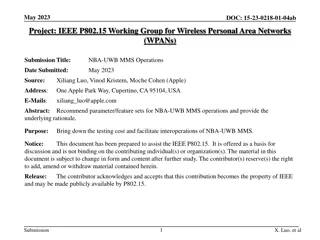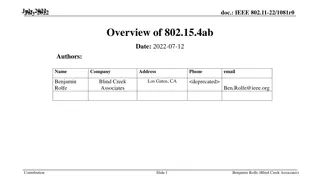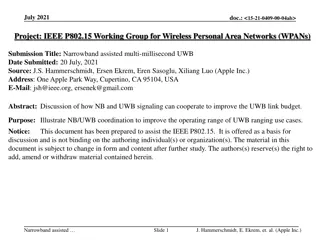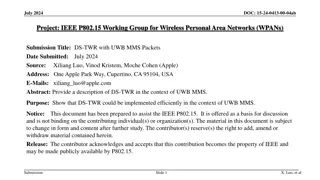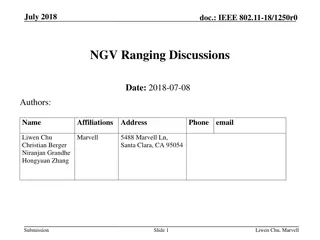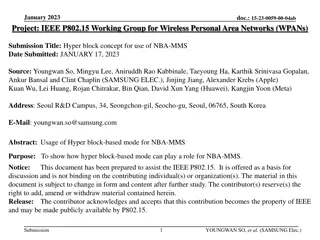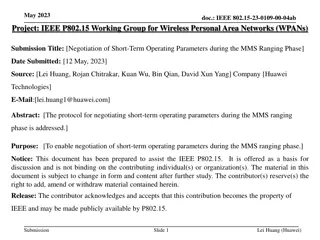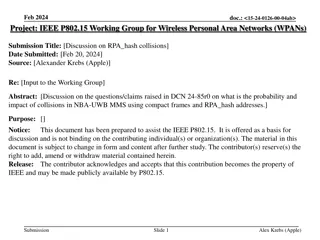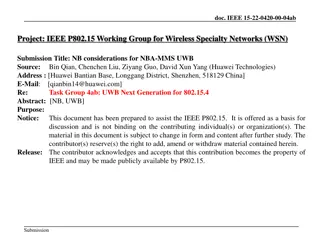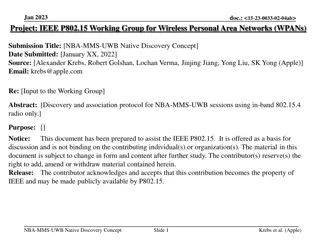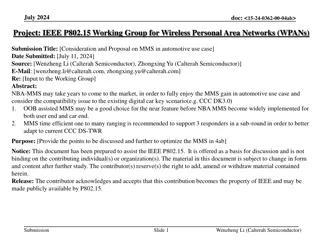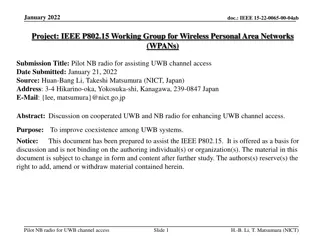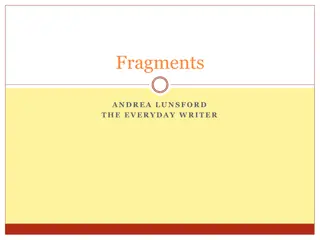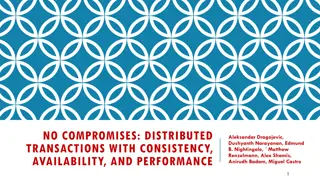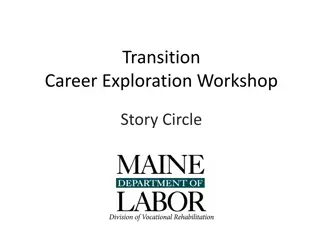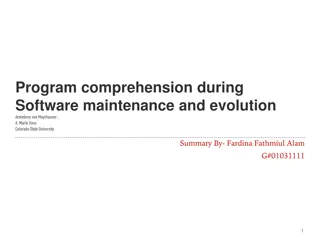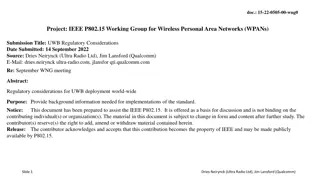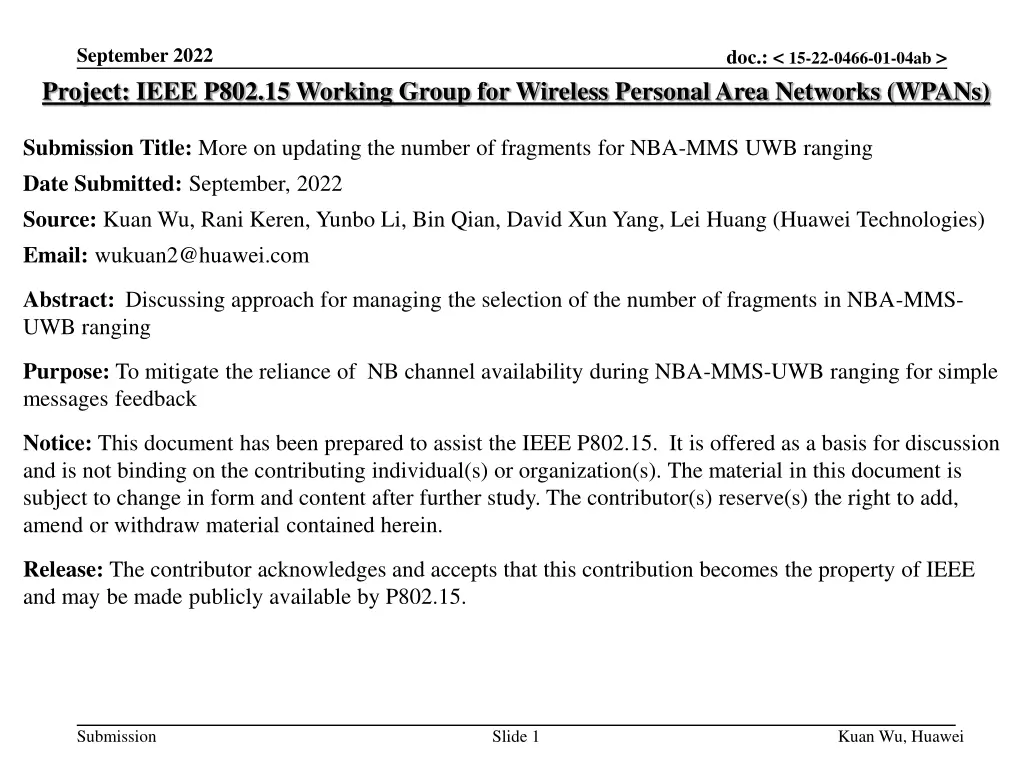
Managing Number of Fragments for NBA-MMS UWB Ranging
Explore the discussion on updating the number of fragments for NBA-MMS UWB ranging to improve reliability and reduce reliance on channel availability. This document presents solutions and safeguards for high-throughput data use cases, interference mitigation, coexistence improvement, and enhanced ranging capabilities in wireless personal area networks.
Download Presentation

Please find below an Image/Link to download the presentation.
The content on the website is provided AS IS for your information and personal use only. It may not be sold, licensed, or shared on other websites without obtaining consent from the author. If you encounter any issues during the download, it is possible that the publisher has removed the file from their server.
You are allowed to download the files provided on this website for personal or commercial use, subject to the condition that they are used lawfully. All files are the property of their respective owners.
The content on the website is provided AS IS for your information and personal use only. It may not be sold, licensed, or shared on other websites without obtaining consent from the author.
E N D
Presentation Transcript
September 2022 Project: IEEE P802.15 Working Group for Wireless Personal Area Networks (WPANs) doc.: < 15-22-0466-01-04ab > Submission Title: More on updating the number of fragments for NBA-MMS UWB ranging Date Submitted: September, 2022 Source: Kuan Wu, Rani Keren, Yunbo Li, Bin Qian, David Xun Yang, Lei Huang (Huawei Technologies) Email: wukuan2@huawei.com Abstract: Discussing approach for managing the selection of the number of fragments in NBA-MMS- UWB ranging Purpose: To mitigate the reliance of NB channel availability during NBA-MMS-UWB ranging for simple messages feedback Notice: This document has been prepared to assist the IEEE P802.15. It is offered as a basis for discussion and is not binding on the contributing individual(s) or organization(s). The material in this document is subject to change in form and content after further study. The contributor(s) reserve(s) the right to add, amend or withdraw material contained herein. Release: The contributor acknowledges and accepts that this contribution becomes the property of IEEE and may be made publicly available by P802.15. Submission Slide 1 Kuan Wu, Huawei
September 2022 doc.: < 15-22-0466-01-04ab > PAR Objective Proposed Solution (how addressed) Safeguards so that the high throughput data use cases will not cause significant disruption to low duty-cycle ranging use cases Interference mitigation techniques to support higher density and higher traffic use cases Other coexistence improvement Backward compatibility with enhanced ranging capable devices (ERDEVs) Improved link budget and/or reduced air-time Discussion on the number of fragments for NBA-MMS UWB Additional channels and operating frequencies Improvements to accuracy / precision / reliability and interoperability for high-integrity ranging Reduced complexity and power consumption Hybrid operation with narrowband signaling to assist UWB Discussion on alleviating the reliance on NB channel availability for conveying simple message(s) Enhanced native discovery and connection setup mechanisms Sensing capabilities to support presence detection and environment mapping Low-power low-latency streaming Higher data-rate streaming allowing at least 50 Mbit/s of throughput Support for peer-to-peer, peer-to-multi-peer, and station-to- infrastructure protocols Infrastructure synchronization mechanisms Submission Slide 2 Kuan Wu, Huawei
September 2022 doc.: < 15-22-0466-01-04ab > Related Contributions [1] 6 GHz WAS/RLAN; Harmonised Standard for access to radio spectrum , Draft ETSI EN 303 687 V1.0.0 (2022-04) [2] 15-22-0261-00-04ab-coexistence-discussion-on-nb-assisted-uwb (May, 2022), Bin Tian et al [3] 15-22-0340-01-04ab-narrowband-channel-access-and-interference-mitigation-for-nba-mms-uwb (July, 2022), Alexander Krebs et al [4] 15-22-0381-00-04ab-nba-uwb-ranging-text-proposal-for-15-4ab-tfd (July, 2022) , Yong Liu et al [5] 15-22-0378-00-04ab-on-the-selection-of-number-of-fragments-in-mms-uwb (July, 2022) , Rani Keren, Kuan Wu et al [6] 15-22-0470-01-04ab-more-on-4ab-preambles-apeval-results-and-recommendations (September, 2022), Vinod Kristem, et al Submission Slide 3 Kuan Wu, Huawei
September 2022 Recap: Listen-before-Talk (LBT) for narrowband (NB) access doc.: < 15-22-0466-01-04ab > LBT for NB access is required for UNII-5 by ETSI regulatory rule [1]. Frame based LBT is recommended for NB-assisted multi-millisecond UWB (NBA-MMS UWB) [2]-[4]. Specifically, if NB channel is occupied, then retry the NB transmission at next fixed time. Fits for MMS structure in terms of reliable UWB scheduling and energy savings. Terminology & Requirements for FBE LBT by ETSI [1], including but not limited to: Fixed Frame Periods (FFP): periodic timing of the transmit/receive structure for frame-based equipment (FBE). Channel Occupancy Time (COT): The total time during which FBE can have transmissions on a given channel, for a given FFP. The FBE can have multiple transmissions within a COT without performing an additional CCA on this channel, providing the gap between such transmissions does not exceed 16 s. Example illustration of the requirements of FBE LBT for NB access in UNII-5 [1] Submission Slide 4 Kuan Wu, Huawei
September 2022 doc.: < 15-22-0466-01-04ab > Recap: LBT in NBA-MMS UWB Considerations of LBT in NBA-MMS UWB ranging measurement [1] If LBT is required before a NB transmission in the corresponding operating band, a transmitter shall perform LBT in advance of the start of the expected transmission. If the performed LBT cannot warrant the transmission at the beginning of the ranging slot, the transmitter shall not commence the transmission. Typical applicable periods such as NBA-MMS-UWB ranging control phase and measurement report phase Observation: If LBT for NB is required, then NBA-MMS ranging is subject to the availability of NB access. Submission Slide 5 Kuan Wu, Huawei
September 2022 doc.: < 15-22-0466-01-04ab > Introduction (cont.) Previous contribution studied the selection of number of ranging sequence fragments (RSF) in NBA- MMS-UWB ranging [5]. Option 1: Dynamic update of the number of RSFs at the measurement report phase. Option 2: Fixed selection preconfigured to the largest number of RSFs prior to the ranging phase. Observation: Updating the number of RSFs within the ranging phase has not yet been discussed [5]. Submission Slide 6 Kuan Wu, Huawei
September 2022 doc.: < 15-22-0466-01-04ab > Introduction (cont.) Intuitively, if either side needs to request an early termination of the MMS ranging phase, then this request message can be conveyed by the NB message. As mentioned in previous slides, if the gap between two consecutive NB messages may be far larger than 16 s (For example, the NB Poll and the NB change request as shown in the following figure), then LBT is required for NB request message. However, if the performed LBT (if required) cannot warrant the NB access, then the request message for early termination can not be conveyed to the other side. Observation: The updating message(s) by NB feedback within the ranging phase is also subject to the availability of NB access. Submission Slide 7 Kuan Wu, Huawei
September 2022 doc.: < 15-22-0466-01-04ab > Motivation During transmission of MMS RSFs, enable the receiving side to request an early termination of the MMS procedure in case the number of RSF it has already received is sufficient for a reliable ranging measurement. May result in a faster and more fluent adaptation to changing channel conditions: Transmission of redundant RSFs is not required in case channel conditions improve and requiring fewer fragments than the pre-configured number of RSFs. By setting the pre-configured number of RSFs to be higher than required by current channel conditions, a sufficient number of RSFs may immediately apply once channel conditions are degraded. Avoiding failed MMS procedures with insufficient number of RSFs during the response to the degrading conditions. Need to define an alternative method for conveying the early termination request when NB access are unavailable due to collisions during MMS ranging phase Submission Slide 8 Kuan Wu, Huawei
September 2022 The feedback is conveyed by the change of preambles If the performed LBT cannot warrant the transmission of NB message, then the request is conveyed by the change of multi-millisecond ranging sequences (MMRS) carried by RSFs The change of MMRSs indicates that the number of RSFs is sufficient for aggregation processing, further RSFs are no longer needed. The MMRSs before and after the change are selected from the same set of sequences, i.e., ranging sequences based on complimentary sets [6], or the set of Ipatov sequences. doc.: < 15-22-0466-01-04ab > (a) Originally with 8 RSFs intended for UWB MMS ranging phase (b) Request for an early termination of UWB MMS ranging phase Submission Slide 9 Kuan Wu, Huawei
September 2022 The feedback is conveyed by the change of preambles (cont.) doc.: < 15-22-0466-01-04ab > The change operation is jointly determined by both sides (initiator/responder) Two-way manner can serve as an ack mechanism for confirming to the other side that the change message has been successfully interpreted. In case the responding side misses/mis-detects the RSFs with the MMRS after the change The initiator repeats the transmission of RSFs with the MMRS after the change until the responding side detects it or until the transmitted number of RSFs reaches the max allowed number. The responder repeats the transmission of RSFs with the MMRS before the change, until it successfully detects RSFs with the MMRS before the change or until the transmitted number of RSFs reaches the max allowed number. For the ease of the receiving side, the responder may optionally detect whether there is any change of MMRSs only at some specific timing check points (Optional). Avoiding frequent detections with multiple correlations for different MMRSs at the responder side to reduce false detection probability of MMRSs at the receiver side. Specifying check-points to detect the change of MMRSs, for example, at slot 4 and 8 Submission Slide 10 Kuan Wu, Huawei
September 2022 doc.: < 15-22-0466-01-04ab > Summary An implicit method to request an early termination of the MMS ranging phase without explicit NB indication An alternative method to convey the request when NB access are unavailable due to collisions Indicating the change of the number of RSFs by changing the MMRSs carried by RSFs Specifying time check points for the ease of the receiving side Submission Slide 11 Kuan Wu, Huawei

